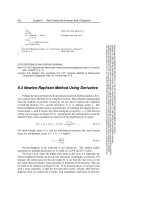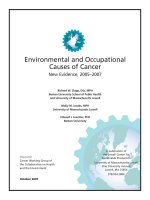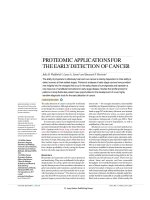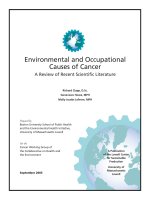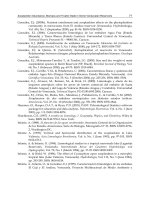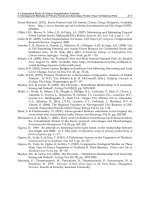Chapter 078. Prevention and Early Detection of Cancer (Part 5) pdf
Bạn đang xem bản rút gọn của tài liệu. Xem và tải ngay bản đầy đủ của tài liệu tại đây (51.01 KB, 5 trang )
Chapter 078. Prevention and Early
Detection of Cancer
(Part 5)
Chemoprevention of Breast Cancer
Hormonal manipulation is being tested in the primary prevention of breast
cancer. Tamoxifen is an antiestrogen with partial estrogen agonistic activity in
some tissues, such as endometrium and bone. One of its actions is to upregulate
transforming growth factor β, which decreases breast cell proliferation. In
randomized placebo-controlled trials to assess tamoxifen as adjuvant therapy for
breast cancer, tamoxifen reduced the number of new breast cancers in the opposite
breast by more than a third. In a randomized placebo-controlled prevention trial
involving >13,000 women at high risk, tamoxifen decreased the risk of developing
breast cancer by 49% (from 43.4 to 22.0 per 1000 women) after a median follow-
up of nearly 6 years. The International Breast Cancer Intervention Study (IBIS-I)
trial had similar findings. In both studies tamoxifen also reduced bone fractures; a
small increase in risk of endometrial cancer, stroke, pulmonary emboli, and deep
vein thrombosis was noted. Tamoxifen has been approved by the U.S. Food and
Drug Administration for reduction of breast cancer in women at high risk for the
disease (1.66% risk at 5 years based on the Gail risk model:
/>ovarian/healthprofessional#Section_66).
A trial comparing tamoxifen with another selective estrogen receptor
modulator, raloxifene, showed that raloxifene is comparable to tamoxifen in
cancer prevention. Raloxifene is associated with more noninvasive breast cancer
than tamoxifen; the drugs are similar in risks of other cancers, fractures, ischemic
heart disease, and stroke. Because the aromatase inhibitors are even more effective
than tamoxifen in adjuvant breast cancer therapy, it is hoped that they also are
more effective in breast cancer prevention. However, no data are available on this
point.
Chemoprevention of Prostate Cancer
Finasteride is a 5-α-reductase inhibitor. It inhibits conversion of
testosterone to dihydrotestosterone (DHT), a potent stimulator of prostate cell
proliferation. The Prostate Cancer Prevention Trial randomly assigned men ≥55
years at average risk of prostate cancer to finasteride or placebo. After 7 years of
therapy, the incidence of prostate cancer was 18.4% in the finasteride arm and
24.8% in the placebo arm, a statistically significant difference. However, the
finasteride group had more patients with tumors of Gleason score 7 and higher
compared to the placebo arm (6.4% vs 5.1%). The clinical significance of this
finding, if any, is unknown.
Selenium is being tested as a prostate cancer preventive based on laboratory
studies, epidemiologic data, and a small randomized skin cancer prevention trial
that showed a significantly decreased number of prostate cancers in men taking
selenium. In the placebo group, 16 prostate cancers were diagnosed versus 4 in the
treatment group among the 843 men who began the study with a serum prostate
specific antigen level <4 ng/mL.
The ATBC study cited above showed in secondary analysis that the risk of
prostate cancer was reduced 33% in men taking α-tocopherol (99 cases in those on
the drug; 151 cases on placebo). A prospective randomized trial to assess these
drugs is ongoing.
Vaccines and Cancer Prevention
A number of infectious agents cause cancer. Hepatitis B and C are linked to
liver cancer, some human papilloma virus (HPV) strains are linked to cervical and
head and neck cancer, and Helicobacter pylori is associated with gastric cancer
and lymphoma. Vaccines to protect against these agents may reduce the risk of
their associated cancers.
The hepatitis B vaccine is effective in preventing hepatitis and hepatomas
due to chronic hepatitis B infection. Public health officials are encouraging
widespread administration of the hepatitis B vaccine, especially in Asia, where the
disease is epidemic.
A four-valent HPV vaccine (Gardasil) is 100% effective at preventing
infection with any of the four component strains (6, 11, 16, 18). The vaccine is
recommended for girls and women ages 9–26 years. Reduction in these HPV types
could prevent >70% of the cervical cancers worldwide.
Surgical Prevention of Cancer
Some organs in some individuals are at such high risk of developing cancer
that surgical removal of the organ at risk is recommended. Women with severe
cervical dysplasia are treated with conization and occasionally even hysterectomy.
Colectomy is used to prevent colon cancer in patients with familial polyposis or
ulcerative colitis.
Prophylactic bilateral mastectomy is chosen for breast cancer prevention
among women with genetic predisposition to breast cancer. In a prospective series
of 139 women with BRCA1 and BRCA2 mutations, 76 chose to undergo
prophylactic mastectomy and 63 chose close surveillance. At 3 years, no cases of
breast cancer had been diagnosed in those opting for surgery, but eight in the
surveillance group had developed breast cancer. A larger retrospective cohort
study reported that prophylactic mastectomy could reduce risk of breast cancer by
90%. The effect of the procedure on mortality is unknown. Observational studies
are prone to a variety of biases associated with the choice to undergo prophylactic
surgery; thus, such studies can give an overestimate of the magnitude of benefit.
Surgery is also used to manage hormonal cancers. Orchiectomy is an
effective method of androgen deprivation in prostate cancer, and oophorectomy is
effective in hormone-dependent breast cancer.
